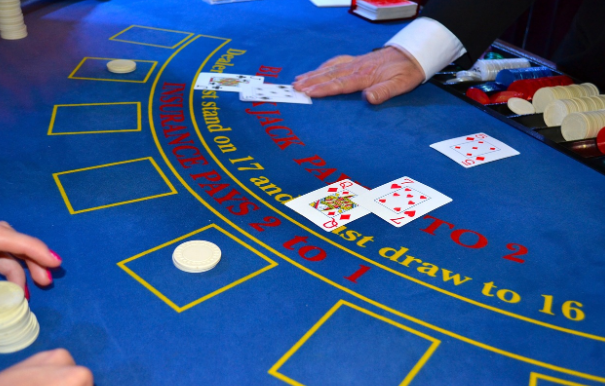Blackjack, also known as twenty-one, has captivated casino patrons for centuries. Its allure lies in the perfect blend of chance and skill. While a lucky hand can turn the tide, mastering basic strategy equips you to make informed decisions and significantly improve your odds of winning.
Let’s check into the essential blackjack strategies you should learn today to elevate your game from novice to a more strategic player.
The Foundation: Basic Strategy
The cornerstone of blackjack success is basic strategy. It’s a roadmap that dictates the statistically optimal play for every scenario you encounter at the table. This strategy considers the value of your two initial cards (your hand) and the dealer’s face-up card (up card). By understanding the probabilities associated with each situation, basic strategy guides you towards maximising your wins and minimising losses.
Many resources, including online charts and Online blackjack strategy books, can equip you with this knowledge. These charts typically depict a matrix where rows represent your hand value and columns showcase the dealer’s up card.
Each cell recommends the optimal action, be it “hit” (taking another card), “stand” (staying with your current hand total), “double down” (doubling your bet in exchange for one more card), or “split” (separating a pair into two independent hands).
Simple Strategies
- Standing on 17 or Higher: Once your hand reaches a value of 17 or more, the gamble of exceeding 21 (busting) outweighs the potential benefit of drawing another card. In this scenario, the basic strategy dictates that you should “stand.”
- Doubling Down on 9, 10, or 11: When you possess a strong hand like a 9, 10, or 11, a basic strategy often recommends “doubling down.” This aggressive manoeuvre allows you to capitalise on your advantage against the dealer by doubling your initial wager in exchange for a single additional card.
- Splitting Aces and Eights: Splitting allows you to transform a single hand into two separate ones. The basic strategy generally advises splitting Aces and 8s. Both starting points offer a good chance of building a strong hand after splitting.
- Never Splitting Tens: While splitting might seem intuitive, the basic strategy discourages splitting tens. Two 10-valued cards (tens, jacks, queens, and kings) already amount to a formidable value of 20. Splitting them creates two weaker hands, decreasing your odds of winning.
Utilising Surrender (if Available)
This strategy, not offered at all casinos, allows you to forfeit half your bet after seeing your initial two cards and the dealer’s up card. This might seem counterintuitive, but it can be advantageous in specific situations.
When facing a strong dealer-up card (like a 10 or an Ace) and holding a weak hand (like a pair of low cards or a total of 15 or 16), surrendering minimises your losses compared to potentially busting if you hit another card.
Capitalising on Insurance (Use with Caution)
Insurance is a side bet offered when the dealer’s up card is an Ace. It lets you wager whether the dealer has a blackjack (a ten-valued card or an Ace as their second card). If you suspect the dealer has a strong hand, this bet can be tempting, but proceed cautiously.
The house edge on insurance bets is very high, so only consider it in specific situations and with a small portion of your initial bet.
Card Counting: Unveiling the Deck's Secrets
The most renowned advanced strategy is card counting. It’s a mental exercise that involves keeping track of the cards that have already been played to estimate the remaining composition of the deck.
Why is this valuable? A deck rich in high-value cards (tens and aces) favours the player, while a depleted deck benefits the dealer. You can adjust your betting strategy by gauging the deck’s composition (known as the “true count”).
- High Card Values Favour the Player: When the deck is rich in high cards (tens and aces), the dealer has a higher chance of busting (exceeding 21). This presents a golden opportunity for the player to win.
- Low Card Values Favour the Dealer: Conversely, a deck depleted of high cards increases the likelihood of the dealer drawing a valuable card to make a strong hand. In this scenario, the player is at a disadvantage.
Other Card-Counting Systems
There are numerous card counting systems, each with varying complexity. Here’s a brief overview of two popular methods:
- Hi-Lo: This beginner-friendly system assigns values to cards. Low cards (2-6) are assigned a value of +1, high cards (10s and aces) are assigned a value of -1, and all other cards (7, 8, 9) are neutral (valued at 0). You can estimate the true count by keeping a running total of these values.
- Hi-Opt I (High Option 1): This more complex system assigns different values to cards based on the number of decks in play. It offers greater accuracy than Hi-Lo but requires more practice to master.
Final Words
Mastering blackjack is a continuous learning process. Diligently practising basic strategy, exploring advanced techniques when appropriate, and implementing sound bankroll management practice can help you on your way to becoming a more confident and informed blackjack player.
Remember, even with perfect strategy, the house edge still exists in blackjack. The casino always has a slight mathematical advantage. However, by employing the above mentioned strategies, you can significantly reduce this edge and increase your chances of walking away a winner.







